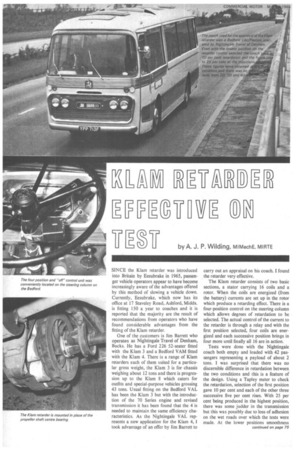by A. J. P. Wilding, MIMechE, MIRTE SINCE the Klam
Page 74

If you've noticed an error in this article please click here to report it so we can fix it.
retarder was introduced into Britain by Eesubrake in 1965, passenger vehicle operators appear to have become increasingly aware of the advantages offered by this method of slowing a vehicle down. Currently, Eesubrake, which now has its office at 17 Staveley Road, Ashford, Middx. is fitting 150 a year to coaches and it is reported that the majority are the result of recommendations from operators who have found considerable advantages from the fitting of the Klam retarder.
One of the customers is Jim Barrett who operates as Nightingale Travel of Denham, Bucks. He has a Ford 226 52-seater fitted with the Klam 3 and a Bedford YAM fitted with the Klam 4. There is a range of Klam retarders each of them suited for a particular gross weight, the Klam 3 is for chassis weighing about 12 tons and there is progression up to the Klam 8 which caters for outfits and special-purpose vehicles grossing 43 tons. Usual fitting on the Bedford VAL has been the Klam 3 but with the introduction of the 70 Series engine and revised transmission it has been found that the 4 is needed to maintain the same efficiency characteristics. As the Nightingale VAL represents a new application for the Klam 4, I took advantage of an offer by Jim Barrett to
carry out an appraisal on his coach. I found the retarder very effective.
The Klam retarder consists of two basic sections, a stator carrying 16 coils and a rotor. When the coils are energized (from the battery) currents are set up in the rotor which produce a retarding effect. There is a four-position control on the steering column which allows degrees of retardation to be selected. The actual control of the current to the retarder is through a relay and with the first position selected, four coils are energized and each successive position brings in four more until finally all 16 are in action.
Tests were done with the Nightingale coach both empty and loaded with 42 passengers representing a payload of about 2 tons. I was surprised that there was no discernible difference in retardation between the two conditions and this is a feature of the design. Using a Tapley meter to check the retardation, selection of the first position gave 10 per cent and each of the other three successive five per cent rises. With 25 per cent being produced in the highest position, there was some judder in the transmission but this was possibly due to loss of adhesion on the wet roads over which the tests were made. At the lower positions smoothness








































































































































